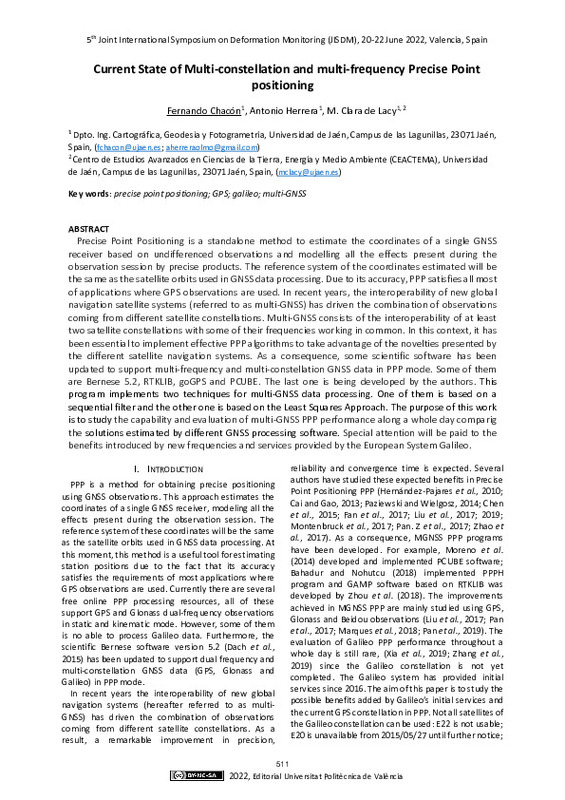JavaScript is disabled for your browser. Some features of this site may not work without it.
Buscar en RiuNet
Listar
Mi cuenta
Estadísticas
Ayuda RiuNet
Admin. UPV
Current State of Multi-constellation and multi-frequency Precise Point Positioning
Mostrar el registro sencillo del ítem
Ficheros en el ítem
| dc.contributor.author | Chacón, Fernando
|
es_ES |
| dc.contributor.author | Herrera, Antonio
|
es_ES |
| dc.contributor.author | de Lacy, M. Clara
|
es_ES |
| dc.date.accessioned | 2023-03-06T13:53:46Z | |
| dc.date.available | 2023-03-06T13:53:46Z | |
| dc.date.issued | 2023-01-27 | |
| dc.identifier.isbn | 9788490489796 | |
| dc.identifier.uri | http://hdl.handle.net/10251/192352 | |
| dc.description.abstract | [EN] Precise Point Positioning is a standalone method to estimate the coordinates of a single GNSS receiver based on undifferenced observations and modelling all the effects present during the observation session by precise products. The reference system of the coordinates estimated will be the same as the satellite orbits used in GNSS data processing. Due to its accuracy, PPP satisfies all most of applications where GPS observations are used. In recent years, the interoperability of new global navigation satellite systems (referred to as multi-GNSS) has driven the combination of observations coming from different satellite constellations. Multi-GNSS consists of the interoperability of at least two satellite constellations with some of their frequencies working in common. In this context, it has been essential to implement effective PPP algorithms to take advantage of the novelties presented by the different satellite navigation systems. As a consequence, some scientific software has been updated to support multi-frequency and multi-constellation GNSS data in PPP mode. Some of them are Bernese 5.2, RTKLIB, goGPS and PCUBE. The last one is being developed by the authors. This program implements two techniques for multi-GNSS data processing. One of them is based on a sequential filter and the other one is based on the Least Squares Approach. The purpose of this work is to study the capability and evaluation of multi-GNSS PPP performance along a whole day comparig the solutions estimated by different GNSS processing software. Special attention will be paid to the benefits introduced by new frequencies and services provided by the European System Galileo. | es_ES |
| dc.description.sponsorship | This research has been funded by: University of Jaén: Programa Operativo FEDER Andalucía 2014-2020 -Project 1263446 - call made by UJA 2018. POAI UJA 2021-2022 and CEACTEMA. Junta de Andalucía: Plan Andaluz de Investigación. Desarrollo e Innovación PAIDI2020 – Project PY20_00897. Project P07-RNM-03087 and Research Group RNM282. MINECO of Spain: Project Project CGL2016-78577-P. | es_ES |
| dc.format.extent | 5 | es_ES |
| dc.language | Inglés | es_ES |
| dc.publisher | Editorial Universitat Politècnica de València | es_ES |
| dc.relation.ispartof | 5th Joint International Symposium on Deformation Monitoring (JISDM 2022) | |
| dc.rights | Reconocimiento - No comercial - Compartir igual (by-nc-sa) | es_ES |
| dc.subject | Global Navigation Satellite system (GNSS) | es_ES |
| dc.subject | MGNSS positioning | es_ES |
| dc.subject | Precise point positioning | es_ES |
| dc.subject | GPS | es_ES |
| dc.subject | Galileo | es_ES |
| dc.subject | Multi-GNSS | es_ES |
| dc.title | Current State of Multi-constellation and multi-frequency Precise Point Positioning | es_ES |
| dc.type | Capítulo de libro | es_ES |
| dc.type | Comunicación en congreso | es_ES |
| dc.relation.projectID | info:eu-repo/grantAgreement/MINECO/Plan Estatal de Investigación Científica y Técnica y de Innovación 2013- 2016/CGL2016-78577-P/ES/CONTEXTO GEOLOGICO, TAFONONOMIA Y PALEOBIOLOGIA DE LOS YACIMIENTOS DEL PLEISTOCENO INFERIOR DE ORCE (CUENCA DE GUADIX-BAZA) | es_ES |
| dc.relation.projectID | info:eu-repo/grantAgreement/Junta de Andalucia/PAIDI2020/P07-RNM-03087 | es_ES |
| dc.relation.projectID | info:eu-repo/grantAgreement/Junta de Andalucia/PAIDI2020/PY20_00897 | es_ES |
| dc.rights.accessRights | Abierto | es_ES |
| dc.description.bibliographicCitation | Chacón, F.; Herrera, A.; De Lacy, MC. (2023). Current State of Multi-constellation and multi-frequency Precise Point Positioning. En 5th Joint International Symposium on Deformation Monitoring (JISDM 2022). Editorial Universitat Politècnica de València. 511-515. http://hdl.handle.net/10251/192352 | es_ES |
| dc.description.accrualMethod | OCS | es_ES |
| dc.relation.conferencename | 5th Joint International Symposium on Deformation Monitoring | es_ES |
| dc.relation.conferencedate | Junio 20-22, 2022 | es_ES |
| dc.relation.conferenceplace | València, España | es_ES |
| dc.relation.publisherversion | http://ocs.editorial.upv.es/index.php/JISDM/JISDM2022/paper/view/13626 | es_ES |
| dc.description.upvformatpinicio | 511 | es_ES |
| dc.description.upvformatpfin | 515 | es_ES |
| dc.type.version | info:eu-repo/semantics/publishedVersion | es_ES |
| dc.relation.pasarela | OCS\13626 | es_ES |
| dc.contributor.funder | Ministerio de Economía y Competitividad | es_ES |
| dc.contributor.funder | Junta de Andalucía | es_ES |
| dc.contributor.funder | Universidad de Jaén | es_ES |






